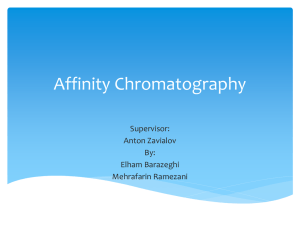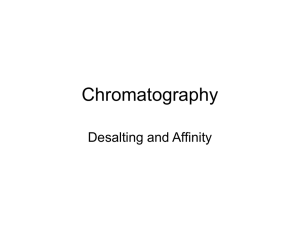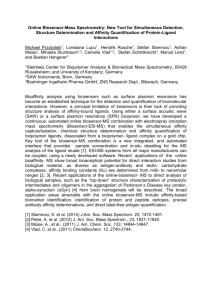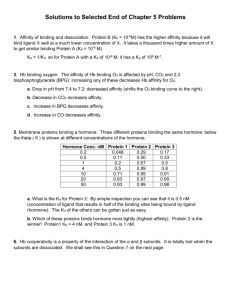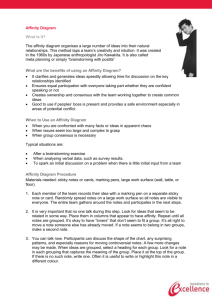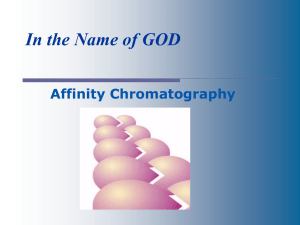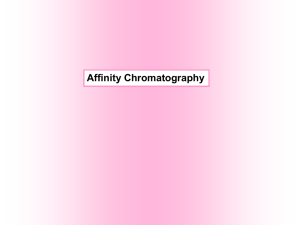Dr. Atiya Abbasi Lecture 05_Affinity_22 jan 2014
advertisement
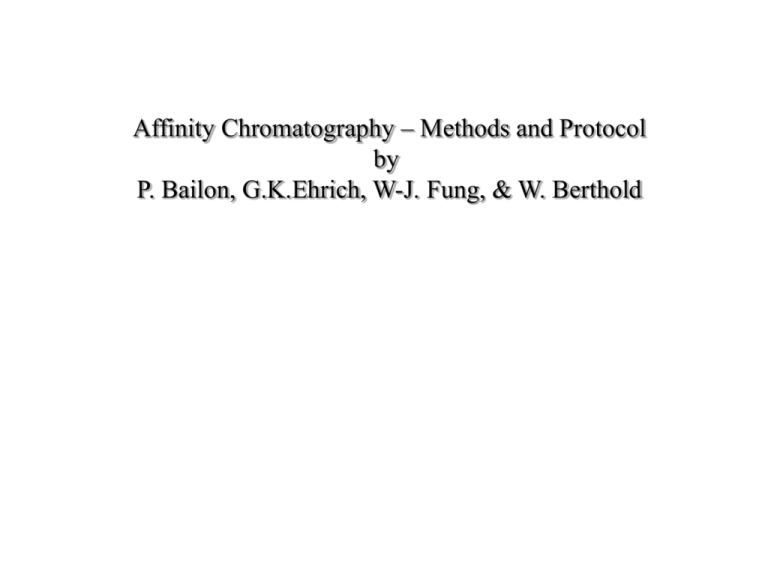
Affinity Chromatography – Methods and Protocol by P. Bailon, G.K.Ehrich, W-J. Fung, & W. Berthold Affinity Chromatography It is based on molecular recognition i.e. it requires an inherent site through which it can recognize a natural or artificial molecule. Affinity chromatography first introduced in 1968 by Pedro Cuatrecasas, Chris Anfinsen, and Meir Wilchek Retention of interacting substances in affinity chromatography principally depends on three distinctive factors: Amount of ligand and ligate, Affinity or avidity between the ligand and ligate, and Physical characteristics of the matrix. Affinity - interaction at an individual binding site Avidity - multivalent binding between multiple binding sites of the ligand and ligate, Strong specific binding is a prerequisite for the successful isolation of an interacting molecule Separates proteins on the basis of a reversible interaction between group present on proteins and a specific ligand coupled to a chromatographic matrix. The technique is ideal for a capture or intermediate step in a purification protocol and can be used whenever a suitable ligand is available for the protein(s) of interest. It has high selectivity, hence high resolution, and high capacity for the protein(s) of interest, purification levels in the order of several thousand-fold with high recovery of active material are achievable. Target protein(s) is collected in a purified, concentrated form. Biological interactions between ligand and target molecule can be a result of electrostatic or hydrophobic interactions, van der Waals' forces and/or hydrogen bonding. The basic requirement for a successful purification is the availability of a suitable biospecific ligand coupled to the chromatographic matrix that interacts reversibly with the target molecule or group of molecules. Almost any component can be used as a ligand to purify its respective binding partner. To elute the target molecule from the affinity medium the interaction can be reversed, either specifically using a competitive ligand, or non-specifically, by changing the pH, ionic strength or polarity. Single step purification can offer immense time-saving over less selective multi-step procedures. The concentrating effect enables large volumes to be processed. Target molecules can be purified from complex biological mixtures, native forms can be separated from denatured forms of the same substance. Small amounts of biological material can be purified from high levels of contaminating substances. The components of the system include: Matrix Ligand Eluent Sample Matrix Characteristics It should exhibit good flow property Stable and resistant - both chemically & mechanically Stable and resistant to microorganisms. Should posses functional groups to attach with ligands Should be economical. Adequate particle size and shape. Increase in particle size reduces flow resistance and resolution Type Examples Biopolymers Agarose Polysaccharrides Cellulose, Starch Synthetic co-polymers Polyacrylamide, Polystyrene Inorganic materials Porous glass, Iron oxide Bio-polymers/Synthetic copolymers Inorganic materials/organic co-polymers Agarose-polyacrylamide Silica/Hydrophilic co-polymer Ligand To bind only to the desired molecule within the solution Attachment to the matrix which is made up of an inert substance. Specific interaction with the desired molecule to form a temporary bond Characteristics of Ligand The ligand must be readily available Ligand must be attached covalently to the matrix such that it retains affinity for the protein Binding must not be neither too strong nor too weak Elution involves passage of high salt or low pH buffer after binding Ligand Specificity AMP Enzymes with NAD cofactors, ATP dependent kinases Arginine Proteases such as prothrombin, Kallikrein, clostripain Cibacron Blue Serum Albumin, Prealbumin Heparin Growth factors, cytokines, coagulation factors Protein A FC region of immunoglobins Calmodulin Calmodulin regulated kinases, cyclases, phosphatases EGTA-Copper Proteins with poly-Histidine tails Some typical biological interactions, frequently used in affinity chromatography include: Enzyme ↔ substrate analogue, inhibitor, cofactor. Antibody ↔ antigen, virus, cell. Lectin ↔ polysaccharide, glycoprotein, cell surface receptor, cell. Nucleic acid ↔ complementary base sequence, histones, nucleic acid polymerase, nucleic acid binding protein. Hormone, vitamin ↔ receptor, carrier protein. Glutathione ↔ glutathione-S-transferase or GST fusion proteins. Metal ions ↔ Poly (His) fusion proteins, native proteins with histidine, cysteine and/or tryptophan residues on their surfaces. Activation and Coupling Affinity chromatography is a five-step process i.e. Activation of the matrix Coupling of ligands Adsorption of the protein Elution and Regeneration of the affinity matrix. Activation of the matrix Activation often been performed with cyanogen bromide New methods are being developed using - Chloroformates, like N-hydroxysuccinimide chloroformate or - Carbonates, carbonyl bis-imidazole or carbonyl (bis- Nhydroxysuccinimide) and hydroxysuccinimide esters. Coupling of ligands The coupling of ligands or proteins to the activated carrier is usually performed at a pH slightly above neutral. Adsorption of the protein Samples should be clear and free from particulate matter. Test the affinity of the ligand: target molecule interaction. Too low affinity will result in poor yields since the target protein may wash through or leak from the column during sample application. Too high affinity will result in low yields since the target molecule may not dissociate from the ligand during elution. Binding of the target protein may be improved by Adjusting the sample to the composition and pH of the binding buffer Sample is usually passed through a desalting column for buffer exchange or diluted with the binding buffer Sample preparation techniques should ensure that components known to interfere with binding (the interaction between the target molecule and the ligand) are removed. Since affinity chromatography is a binding technique, the sample volume does not affect the separation as long as conditions are chosen to ensure that the target protein binds strongly to the ligand. Flow rate influences efficient binding during sample application and needs to be tested as this parameter can vary according to the specific interaction between the target protein and the ligand under different concentrations The column must be pre-equilibrated in binding buffer before beginning sample application. For interactions with strong affinity between the ligand and the target molecule that quickly reach equilibrium, samples can be applied at a high flow rate. For interactions with weak affinity and/or slow equilibrium, a lower flow rate should be used. The optimal flow rate to achieve efficient binding may vary according to the specific interaction and should be determined when necessary. Elution Isocratic elution of a biological macromolecule on an immobilized ligand affinity support under non-chaotropic buffer conditions allows a dynamic equilibrium between association and dissociation. It is directly dependent on the equilibrium constant for the immobilized ligand - macromolecule interaction. Typical Experiment 1. Affinity medium is equilibrated in binding buffer. 2. Sample is applied under conditions that favour specific binding of the target molecule(s) to a complementary binding substance (the ligand). Target substances bind specifically, but reversibly, to the ligand and unbound material washes through the column. 3. Target protein is recovered by changing conditions to favour elution of the bound molecules. 4. Elution is performed specifically, using a competitive ligand, or non-specifically, by changing the pH, ionic strength or polarity. Target protein is collected in a purified, concentrated form. 5. Affinity medium is re-equilibrated with binding buffer. Method 1 The simplest case. A change of buffer composition elutes the bound substance without harming either it or the ligand. Method 2 Extremes of pH or high concentrations of chaotropic agents are required for elution, but these may cause permanent or temporary damage. Methods 3 and 4 Specific elution by addition of a substance that competes for binding. These methods can enhance the specificity of media that use group-specific ligands. Elution Different methods can be used: Non specific Specific Special Non Specific methods pH A change in pH alters the degree of ionization of charged groups on the ligand and/or the bound protein. This change may affect the binding sites directly, reducing their affinity, or cause indirect changes in affinity by alterations in conformation. A step decrease in pH is the most common way to elute bound substances. The chemical stability of the matrix, ligand and target protein determines the limit of pH that may be used. If low pH must be used, collect fractions into neutralization buffer such as 1 M Tris-HCl, pH 9 (60–200 μl/ml eluted fraction) to return the fraction to a neutral pH. The column should also be re-equilibrated to neutral pH immediately Ionic strength The exact mechanism for elution by changes in ionic strength will depend upon the specific interaction between the ligand and target protein. This is a mild elution using a buffer with increased ionic strength (usually NaCl), applied as a linear gradient or in steps. Enzymes usually elute at a concentration of 1 M NaCl or less. Competitive elution Selective eluents are often used to separate substances on a group specific medium or when the binding affinity of the ligand/target protein interaction is relatively high. The eluting agent competes either for binding to the target protein or for binding to the ligand. When working with competitive elution the concentration of competing compound should be similar to the concentration of the coupled ligand. However, if the free competing compound binds more weakly than the ligand to the target molecule, a ten-fold higher concentration than the ligand may be used. Reduced polarity of eluent Conditions are used to lower the polarity of the eluent to promote elution without inactivating the eluted substances. Typically dioxane (up to 10%) or ethylene glycol (up to 50%) are used. Chaotropic eluents If other elution methods fail, deforming buffers, which alter the structure of proteins, can be used, e.g. chaotropic agents such as guanidine hydrochloride or urea. Chaotropes should be avoided whenever possible since they are likely to denature the eluted protein. Gradient and step elution Flow rates It is not possible to specify a single optimal flow rate in affinity chromatography because dissociation rates of ligand/target molecule interactions vary widely. To obtain sharp elution curves and maximum recovery with minimum dilution of separated molecules, lowest acceptable flow rate are used. Preparation of media and buffers Storage solutions and preservatives should be washed away thoroughly before using any affinity medium. Re-swell affinity media (if supplied as freeze-dried powders) in the correct buffer as recommended by the manufacturer. Use high quality water and chemicals. Solutions should be filtered through 0.45 μm or 0.22 μm filters. Reuse of affinity media depends on the nature of the sample and should only be performed with identical samples to prevent cross-contamination. If an affinity medium is to be used routinely, care must be taken to ensure that any contaminants from the crude sample can be removed by procedures that do not damage the ligand. Binding and elution buffers are specific for each affinity medium since it facilitates the interaction between the target molecule and the ligand in affinity based separation. Some affinity media may also require a specific buffer in order to make the medium ready for use again. Magnetic stirrers should be avoided as it may damage the matrix. Use mild rotation or end-over-end stirring. Sample preparation and application Samples should be clear and free from particulate matter. Simple steps to clarify a sample before beginning purification will avoid clogging the column, may reduce the need for stringent washing procedures and can extend the life of the chromatographic medium. If possible, test the affinity of the ligand: target molecule interaction. Too low affinity will result in poor yields since the target protein may wash through or leak from the column during sample application. Too high affinity will result in low yields since the target molecule may not dissociate from the ligand during elution. Binding of the target protein may be made more efficient by adjusting the sample to the composition and pH of the binding buffer Sample preparation techniques should ensure that components known to interfere with binding (the interaction between the target molecule and the ligand) are removed. The sample volume does not affect the separation as long as conditions are chosen to ensure that the target protein binds strongly to the ligand. Flow rate that gives the most efficient binding during sample application should be used The column must be pre-equilibrated in binding buffer before beginning sample application. For interactions with strong affinity between the ligand and the target molecule that quickly reach equilibrium, samples can be applied at a high flow rate. However, for interactions with weak affinity and/or slow equilibrium, a lower flow rate should be used. The optimal flow rate to achieve efficient binding may vary according to the specific interaction and should be determined when necessary. When working with very weak affinity interactions that are slow to reach equilibrium, it may be useful to stop the flow after applying the sample to allow more time for the interaction to take place before continuing to wash the column. Elution of target substances should be attempted only after removal of all unbound material from the column by the binding buffer (determined by UV absorbance at 280 nm). This will improve the purity of the eluted target substance. Biomolecules Purified by Affinity Chromatography 1. Antibodies and antigens 2. Enzymes and inhibitors 3. Regulatory enzymes 4. Dehydrogenases 5. Transaminases 6. Hormone-binding proteins 9. Lectins and glycoproteins 10. RNA and DNA (genes) 11. Bacteria 12. Viruses and phages 13. Cells 14. Genetically engineered proteins 7. Vitamin-binding proteins 8. Receptors 15. Others Techniques that Stem from Affinity Chromatography 1. Immunoaffinity chromatography 2. Hydrophobic chromatography 3. High performance affinity chromatography 4. Lectin affinity chromatography 5. Metal-chelate affinity chromatography 6. Covalent affinity chromatography 7. Affinity electrophoresis chromatography 8. Affinity capillary electrophoresis 9. Dye-ligand affinity chromatography 10. Affinity partitioning 11. Filter affinity transfer chromatography 12. Affinity precipitation 13. Affinity density perturbation 14. Perfusion affinity chromatography 15. Centrifuged affinity chromatography 16. Affinity repulsion chromatography 17. Affinity tails chromatography 18. Theophilic chromatography 19. Membrane-based affinity 20. Weak affinity chromatography 21. Receptor affinity chromatography 22. Avidin-biotin immobilized system 23. Molecular imprinting affinity 24. Library-derived affinity ligands Advantages High degree of purity Reproducibility Investigation of binding sites of biological molecules is very easy Disadvantages Cost, difficulties associated with scale-up and the high labour intensity With such drawbacks affinity chromatography tends to be used in purification of speciality chemicals and pharmaceutical compounds where the need for purity out weighs the production cost Applications Purification of substances from biological mixtures Separation of native from denatured forms of proteins Removal of small amounts of biomaterial from large amounts of contaminants Purify and concentrate a molecule from a mixture in solution at very low concentrations Reduce the amount of substance in a mixture Purify and concentrate an enzyme solution Industrial Applications Affinity chromatography is widely used in the pharmaceutical industry to purify and extract molecules of interest from complex mixture These molecules tend to be not only enzymes, proteins amino acids but other biological species can be selectively retained Once isolated these biological species can be selectively amplified to produce larger quantities.
